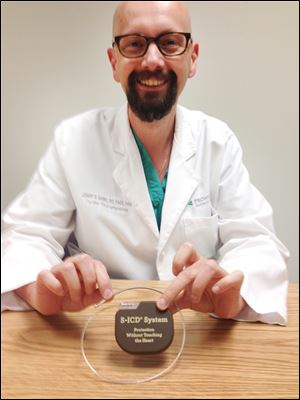
Defibrillator is safer option to standard model
6/26/2014
Dr. John Aasbo, cardiolo-gist at ProMedica Toledo Hospital, with the new defibrillator.
When Ricquel Campbell was told she needed an implanted defibrillator to protect her weak heart from sudden cardiac arrest, the 43-year-old Toledo woman said she was scared and reluctant to have such an invasive surgery.
“I was so outdone when I heard I had a heart problem,” Mrs. Campbell said. “When she said defibrillator, that was like Charlie Brown with the teacher, I heard nothing after that. I think of old people when I think of defibrillator — so not me.”
Dr. Johan Aasbo, a cardiologist at ProMedica Toledo Hospital, helped assuage her fears by telling her she was a candidate for a new type of defibrillator recently approved for use in the United States by the Food and Drug Administration.
The new subcutaneous implantable cardioverter defibrillator, or S-ICD, is smaller and, unlike standard defibrillators used since the 1990s, its wire or lead does not need to touch the heart to work. “It’s safer, less invasive, and in the long run the expectation is the leads chance of lasting for decades and decades is much higher,” Dr. Aasbo said.
Mrs. Campbell’s surgery last January was successful — it took about 90 minutes for the procedure and she was back to her old self in about three weeks. She was one of the first people in Toledo to have this type of defibrillator, which is implanted next to her ribs under her skin. The battery is placed on the side of the chest, under the armpit.
Dr. Aasbo said Mrs. Campbell suffers from cardiomyopathy, a condition in which the electrical heart rhythm is unstable. The heart can begin to beat too fast, making it difficult for her heart to pump blood.
“This device is like a sentinel, it’s like a lifeguard sitting there on the chair and watches the rhythm day in and day out,” the doctor said. “And if that rhythm were ever to happen and if it lasted long enough to hurt Ricquel, then the device would shock her and very likely save her life.”
Dr. Aasbo said there are many thousands of people in the United States that suffer from heart conditions who could benefit from use of a defibrillator.
“The data is difficult to get, but some people estimate that half a million people a year die from sudden cardiac arrest,” he said.
“There still is a large challenge; a third who are candidates don’t get it,” he added.
But many patients and their doctors are leery because of past problems with multiple manufacturers’ recalls of defective leads and high infection rates associated with the wires. Dr. Asabo said corrective surgery to remove wires from hearts and arteries is risky.
“If I would have had to have it the other way [with the old device], I would have took my chances without it,” Mrs. Campbell said.
Dr. Aasbo, who has performed 27 of 30 surgeries in Toledo involving the new, smaller defibrillator since December, said the new design allows him to offer the protection to his heart patients while minimizing risks associated with the standard defibrillator.
Mrs. Campbell said she can feel the implant at times, and it can cause discomfort if she wears undergarments with wires, but it doesn't hinder her daily activities.
She will have to visit Dr. Aasbo every six months for diagnostic tests to ensure the wires and circuitry are working properly.
“The chances of Ricquel needing a shock is one in six over an eight year period,” Dr. Aasbo said.
Contact Marlene Harris-Taylor at mtaylor@theblade.com or 419-724-6091.